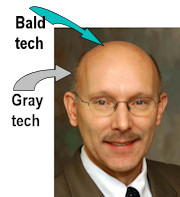In my previous blog entry, I discussed some of the “downswing” trends in IT in local government. This column will be about trends on the upswing – gaining prominence and resources – in cities and counties. Most of this information came from discussions with CIOs of other large cities and counties around the country, held at the Metropolitan Information Exchange (MIX) conference in Albuquerque in September.
On the rise in local government are cloud computing or hosted services, public safety support, geo-location, award-winning websites, social media use (blogging, twitter, Facebook, YouTube), consolidation, hiring chills or freezes, the “greening” of IT and responding to climate change.
MIX members certainly are leaders in online services, as recognized in the Center for Digital Government’s annual best of the web awards. We are all driving more services online, but also struggling to make more data available for transparency and accountability. Those governments receiving awards are doing an exceptional job.
“Cloud computing” or hosted applications or software-as-a-service (SAAS) are finding fertile ground in government, although only the seeds have been planted – just a few applications are sprouting. Bill Greeves, CIO of Roanoke County, Virginia, has been a leader in this field in government, especially with his Muni Gov 2.0 initiative. Bill is also a fellow blogger here on Digital Communities.
As the budgets of IT departments are cut, they no longer have the staff or resources to support applications, sometimes even mission critical ones. Many of us are therefore hosting new applications such as job application or payroll systems in the cloud. The City of Seattle will probably implement both applicant tracking systems (although with budget constraints, jobs are few and far between!) and customer relationship management systems “in the cloud”. Besides ease of support, placing applications “in the cloud” also results in regular software upgrades and predictable costs.
Most MIX cities and counties are not cutting public safety or fire/emergency medical services departments. The City of Seattle, while cutting over 300 city employees in 2010, is preserving the number of firefighters and increasing the police department by 21 officers.
And support for public safety systems such as computer-aided dispatch (CAD) and records management is growing. A side effect of this growth is geo-location or automated-vehicle-location (AVL). Many local governments have implemented it for fire departments and it is seeing increasing use in police, transportation and utilities. AVL allows dispatch of the closest unit to a request for service, shortening response times. During disasters or major incidents, the incident commander and emergency operations center can quickly see and coordinate the deployment of units from many different disciplines to the scene. As one example, the City of Seattle just implemented a new CAD for Police which includes a mapping component showing not just unit locations, but active calls, waiting calls and completed requests.
Social media are seeing an explosion of use (duh!). Social media include blogging, online video (e.g. YouTube), twitter, mashups (data display on a map), and “friend” sites such as Facebook. Every MIX member is trying to figure out how to use these new technologies but at the same time comply with the web (pun intended) of laws for local government, including records retention and public disclosure while somehow preventing degeneration of public comment into the gutter often found in comments on newspaper articles. The City of Seattle just implementedd a series of social media policies, and is robustly using blogs and Twitter, as well as video and Facebook.
Again, Bill Greeves and the Muni Gov 2.0 crew are actively holding meetings and discussions in Second Life, another use of social media.
Next, I’ll mention climate change. Some amount of debate continues to swirl around this topic – is global warming real or not? Is it caused by humans, or flatulating cows? This whole discussion is actually irrelevant. The fact is the public – and their elected officials – are demanding climate-friendly reductions in greenhouse gas emissions, which, by the way, also reduce our use of and dependence upon foreign oil. Mayor Greg Nickels of Seattle just had the 1000th city (Mesa, Arizona) sign the Mayors’ climate protection agreement, an initiative he started in 2005. Bottom line: climate change is something IT departments need to address, too.
Then there is “green technology”. I’m a notable skeptic that technology can ever been “green” (see my blog entry on “gray technology”) although e-recycling programs like Total Reclaim in Seattle are recycling 99% of TVs and computer monitors. Every MIX member jurisdiction is working on green tech. Some of this is almost inadvertent, e.g. lengthening replacement cycles of desktop and server computers due to budget cuts. But other initiatives are quite proactive such as installing power-management software on desktop computers (e.g. from Verdiem), virtualization, and reducing the use of paper. In the future we will probably demand to know which manufacturers and vendors are kindest to the environment and use the lowest carbon emissions in production of their products.
As Rahm Emanuel has stated “You never want a serious crisis to go to waste“. Those of us who are CIOs in local government are trying to balance reduced budgets, make staffing cuts and yet meet the increasing demands for technology by line departments in our governments. And we’ll continue to share our good ideas through organizations such as MIX, publications like Government Technology and Public CIO magazine, and blogs such as these on Digital Communities.
We won’t waste this crisis!




